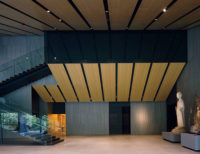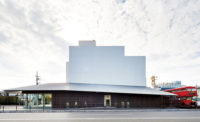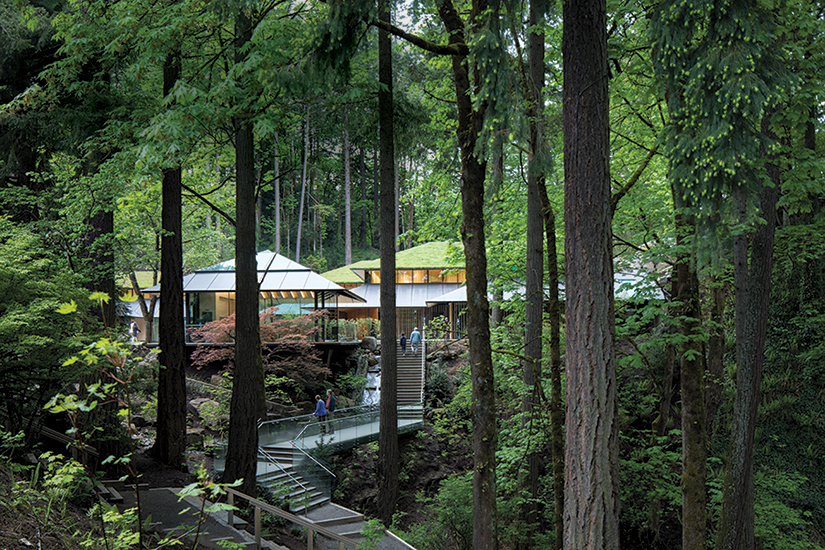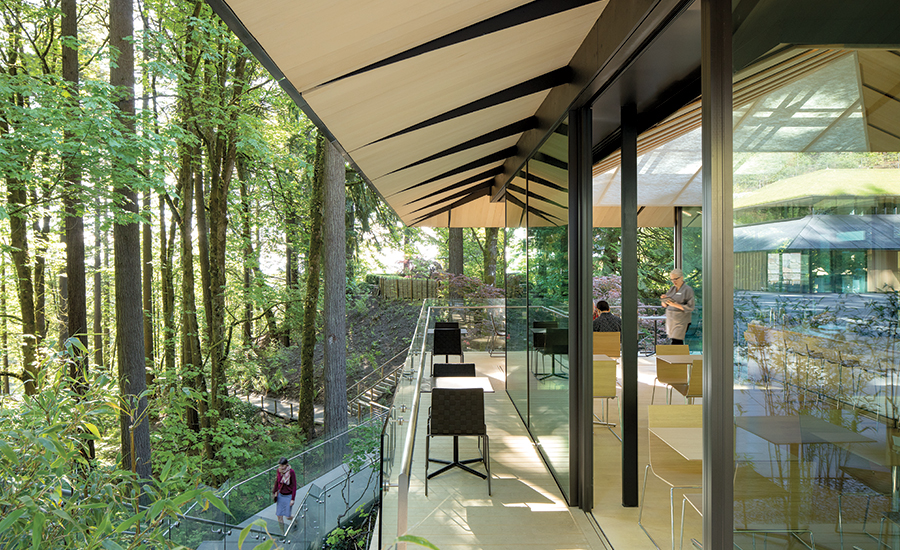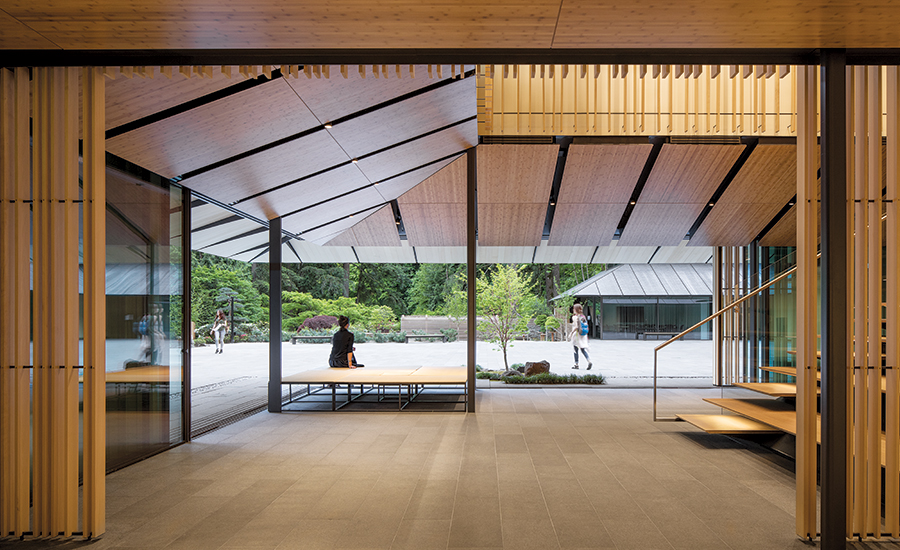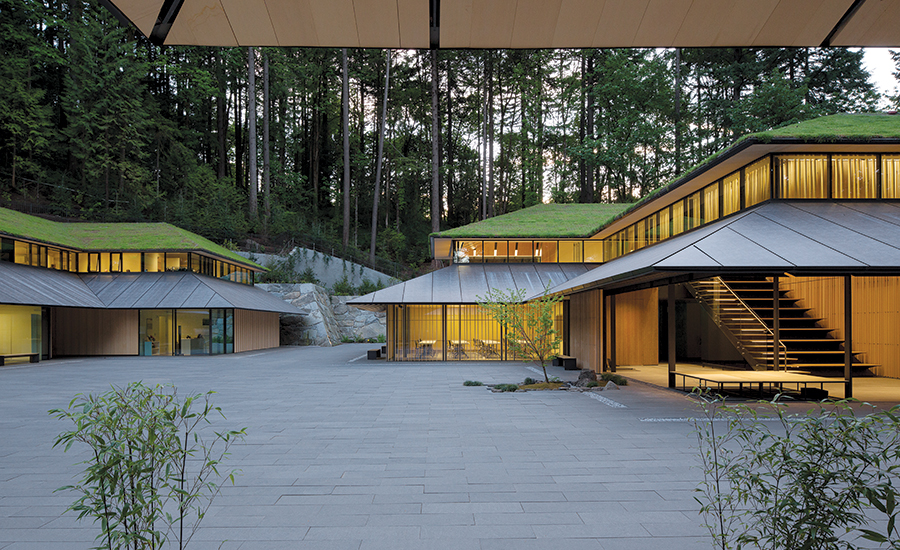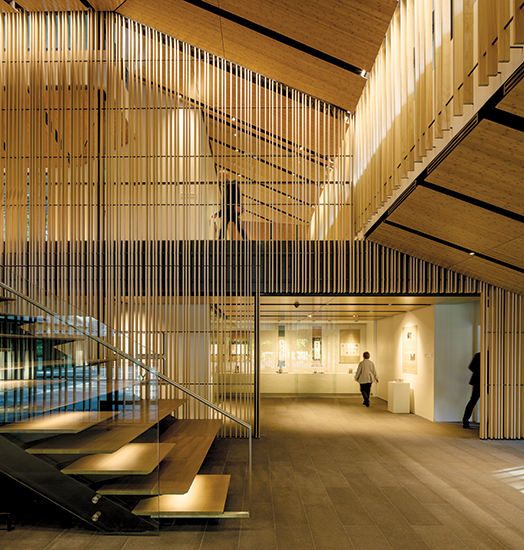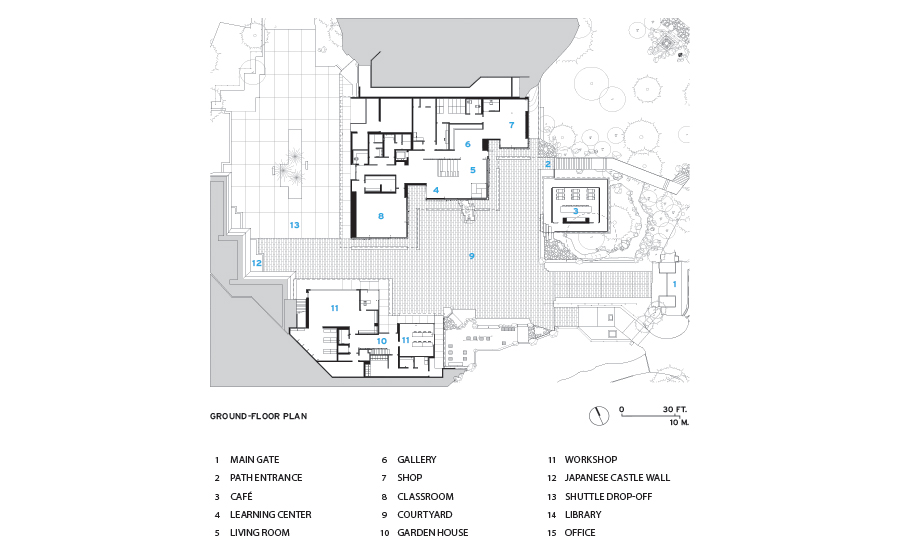Portland Japanese Garden Cultural Village by Kengo Kuma & Associates
Oregon

Approaching the Cultural Village from the ticket office and parking on lower ground, visitors encounter the Umami Café on the left and the Jordan Schnitzer Japanese Arts Learning Center beyond.
Photo © Jeremy Bittermann

Like a traditional engawa, the café’s covered veranda is ideal for a cup of green tea.
Photo © Jeremy Bittermann

Inspired by a classic tsuboniwa (courtyard) garden, a careful composition of rocks with a Japanese maple tree is just outside the Jordan Schnitzer Japanese Arts Learning Center’s Living Room.
Photo © Jeremy Bittermann

Inside, a tatami tea platform floats above the floor.
Photo © Jeremy Bittermann

The café’s dramatic roof, supported by two columns and a massive concrete pier, opens the room to a 270-degree view.
Photo © Jeremy Bittermann

Rough-hewn stone mimicking a Japanese castle rampart conceals a concrete retaining wall.
Photo © Jeremy Bittermann

Delicate wood slats separate the Living Room from a vitrine-lined credits gallery in the Jordan Schnitzer Japanese Arts Learning Center, where steps leading to the second-floor library and offices double as seating.
Photo © Jeremy Bittermann

Image courtesy Kengo Kuma and Associates

Image courtesy Kengo Kuma and Associates









Architects & Firms
Surrounded by majestic Douglas firs, Oregon’s Portland Japanese Garden (PJG) is a piece of Japan transplanted to the Pacific Northwest. As one would expect, the park’s five exquisite landscapes echo the gardens of Kyoto or Kanazawa. The real surprise is its new Cultural Village, created by the Tokyo-based architect Kengo Kuma, that opened in April. Though separated by a vast ocean and wide gaps in construction culture, Kuma’s complex—a trio of buildings clustered around a courtyard—extracts essential elements of Japan’s traditional architecture while steering clear of trite quotation. Importing a keen sensitivity to nature and a meticulous treatment of materials, Kuma’s addition to the PJG is his first major work in the United States. It is a stunning debut.
Additional Content:
Jump to credits & specifications
Situated on city-owned land occupied by the Oregon Zoo in the 1950s, the nonprofit PJG organization was founded in the 1960s, when municipalities were building Japanese gardens coast to coast as part of the post–World War II fence-mending and a growing interest in Japanese culture. Some 50 years later, the PJG was ready for expansion, hoping to become a full-fledged teaching center for the art of Japanese gardening and a place to explore Japanese culture. It designated an adjacent lot for a new center and hosted an invited competition in 2011. “We needed someone to show us contemporary design that nods to the past,” says PJG chief executive officer Stephen Bloom. Kuma’s proposal for a “quiet” architecture that would blend with its setting was the answer.
Leaving the city behind, the PJG welcomes visitors with a new ticket pavilion and cascading pond—a hint of what awaits above. Ascending a hillside via shuttle bus or winding footpath, one finds a soothing hush gradually replacing the sounds of daily life, and a contemplative mood takes over. The Cultural Village begins where the land levels out. Readying the 3.4-acre site was no small undertaking; a chunk of the mountain had to be removed to enlarge the buildable area for the desired program, and the ground had to be lowered by 6 feet to meet ADA accessibility standards. Envisioned as a monzenmachi, a traditional Japanese townscape preceding a sacred precinct, the new compound leads to the existing park. “Instead of one heroic shape, we wanted to achieve harmony with the garden,” explains Kuma. This meant dividing the program among three low-scale buildings and integrating them with lush greenery, including three new gardens created by Sadafumi Uchiyama, the project’s landscape architect and the PJG’s garden Curator. “Both the landscape and the architecture are about polishing what is already there,” says Uchiyama.
Overlooking the slope in front, the Umami Café is the building closest to the entrance. From there, the courtyard connects to the Garden House and the Jordan Schnitzer Japanese Arts Learning Center. The Garden House contains a horticultural teaching studio that doubles as a garage at grade, plus offices and a staff room for the resident gardeners upstairs. The Learning Center opens with the “Living Room,” a gathering place leading to a classroom in one direction and a gallery and gift shop in the other. Grand stairs ascend to the administrative offices and library. The zigzag geometry of these two structures was inspired by Japan’s historic ganko plan, named for its resemblance to flying geese in formation. Like traditional shoji paper screens, sliding glass panels completely open the corners of Kuma’s buildings to the landscape. “Perceptually, the garden space passes through the buildings,” says project architect Balazs Bognar.
Another traditional element born anew is the use of hipped roofs. Reminiscent of Kuma’s café at Tokyo’s Nezu Museum, angled panels cap the café. The Garden House and Learning Center are both topped by double-tiered roofs, the upper layer of each covered with local sedums that blend with the landscape. These plantings help gather rainwater and funnel it into a cleverly disguised drainage system, which is a legal requirement in this landslide zone. The roofs’ lower layers form deep eaves, providing shelter from Portland’s frequent wet weather. Though razorthin eave lines are partly what make Kuma’s architecture so elegant, achieving this effect was one of the project’s greatest construction challenges. “They are thin compared to most American buildings but different from what we were expecting,” says Kuma. Though thicker than hoped for, the roofs’ still taper gracefully and seem to hang effortlessly over the covered slot of space at the base of each building.
Made of aluminum panels with a digitally printed finish that resembles hand burnishing, the eaves exemplify Kuma’s richly textured material palette. Blending local timber and stone with Japanese construction techniques, he chose Oregon-grown Port Orford Cedar for the refined interior surfaces, such as the screens in the Living Room.
Because this high-quality wood is frequently exported for use in Japan’s temples and shrines and is in short supply, Alaskan yellow cedar forms the soffits, louvers, and the yamatobari lapped exterior walls. Made of Baker blue granite quarried nearby, a chunky stone wall modeled after traditional castle ramparts—by the 15th-generation master stonemason Suminori Awata—helps secure the mountain in back. Ironically, the first new Japanese castle wall built in hundreds of years stands in Portland.
No doubt their own exacting construction standards are one reason why some Japanese architects struggle to enter the U.S. market. But another is access to it. “In our experience, Europe tends to sponsor more state and national competitions,” comments Bognar. It is also a matter of finding the right work. “We prefer to be selective about potential projects, since we would like to contribute to American society in the best ways possible; this approach takes time,” he continues. If the Cultural Village is any indication, Kuma’s contribution to the Portland Japanese Garden was well worth the wait.
CreditsArchitect: Kengo Kuma and Associates, Tokyo, Japan, www.kkaa.co.jp
Personnel in architect's firm who should receive special credit: Kengo Kuma; Balazs Bognar AIA, Project Architect
Architect of record: Hacker Architects (Jonah Cohen, Principal in Charge; Jake Freauff, Project Architect; Tyler Nishitani, Project Architect); 733 SW Oak Street, Portland, Oregon; (503) 227-1254; www.hackerarchitects.com
Interior designer: Kengo Kuma and Associates
Engineers Structural: KPFF Consulting Engineers Civil: KPFF Consulting Engineers Geotechnical: GRI Mechanical: PAE Engineers Electrical: PAE Engineers Plumbing: PAE Engineers
Consultants Landscape Architect: Sadafumi Uchiyama Landscape Architect of Record: Walker Macy Sustainability: Green Building Services Lighting: Luma Lighting Design Acoustical: Listen Acoustics Metal roofing: Bassett Construction Interior furnishings: Hacker Architects Gift shop design: Elmslie Osler Architect Signage design: Anderson Krygier
General contractor: Hoffman Construction Company
Photographer: Jeremy Bittermann
|
SpecificationsExterior Cladding Other cladding unique to this project: Custom Japanese castle walls: Suminori Awata (Japan), with Matt Driscoll (O’Driscoll Stone), Kyle Schlagenhauf (Green Man Builders), Ed Lockett (Stone Sculptures), Dan Dunn (Alpine Boulder Company)
Roofing Metal: Pure+Freeform with DNP (Japan) Other: Vegetated ceramic panels: Komatsu Seiren
Doors Entrances: Nakamura Komuten (Japan) Sliding doors: Vitrocsa
Interior Finishes Floor and wall tile: Restroom tile: Lixil/Inax (Japan) Special interior finishes unique to this project: Custom wood screens and café ceiling: Takumi Company Custom main stepped seating and other carpentry: Straight Up Carpentry Gallery fabric wall covering: Lixil/Kawashima Selkon (Japan)
Furnishings Reception furniture: Time & Style (Japan) Other furniture: Library table: George Nakashima Woodworker Library seating: Time & Style (Japan) Café seating: Time & Style (Japan)
Plumbing All plumbing fixtures: DXV, American Standard
Energy Other unique products that contribute to sustainability: Vegetated ceramic panels: Komatsu Seiren
|

